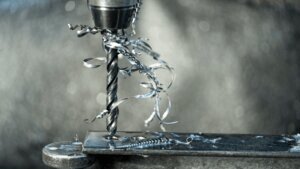What Is the Difference Between CNC Drilling and CNC Milling?
In the field of precision manufacturing, every process determines the quality and cost of the final product. Especially when it comes to operations like “hole making,” which seem simple but can have far-reaching impact, should you choose CNC drilling or CNC milling?
Behind the choice lies a range of core considerations such as efficiency, structural compatibility, and tolerance control. CNC drilling is ideal for efficiently processing standard round holes, while CNC milling excels at handling complex contours and irregular hole shapes. Selecting the right process based on the part structure ensures better efficiency and precision.
This article not only introduces the differences between the two processes but also aims to help you determine which method is more suitable, more efficient, and more reliable under different machining tasks.
1、What Is CNC Drilling?
CNC drilling uses a rotating drill bit that feeds vertically to process standard round holes quickly and efficiently. The entire process is precisely controlled by programs, and it is suitable for high-volume, high-repeatability hole processing tasks.
Typical Features:
The feed direction is vertical along the Z-axis;
Common tools include twist drills, step drills, center drills, etc.;

For deep holes, peck drilling can be used to improve chip evacuation and tool life;
The typical drilling diameter ranges from 0.5 mm to 50 mm, suitable for a wide range of applications.
Application Scenarios:
Flange holes, mounting holes, threaded holes, positioning holes;
Any high-speed, batch processing of standard holes.
2、What Is CNC Milling?
CNC milling offers powerful geometric machining capabilities, especially under multi-axis linkage conditions, enabling flank milling of freeform surfaces and complex profiles. In high-speed machining, the efficiency and surface quality of flank milling can be significantly improved through proper selection of cutting tools and machining parameters.
Capability Features:
The workpiece and tool can move along X, Y, Z axes or even more complex multi-axis motion;
Capable of machining surfaces, slots, holes, inclined surfaces, curved surfaces, 3D profiles, etc.;
Circular interpolation can be used to mill holes, especially for special-shaped holes
Common tools include end mills, ball nose cutters, face mills, etc.

Application Scenarios:
Mold cavities, part surface milling, complex structure machining;
Irregularly shaped holes and slots, offering great machining flexibility.
3. Fundamental Comparison: CNC Drilling vs CNC Milling
Comparison Aspect | CNC Drilling | CNC Milling |
Functional Positioning | Specialized in efficient and precise round hole machining | Versatile machining method for profiles, surfaces, holes, slots, and more |
Tool Path | Mainly vertical feed along the Z-axis | Involves coordinated motion in X, Y, Z axes or multi-axis configurations |
Material Setup | Simple fixturing; multiple holes can be processed in one setup | Higher requirements for clamping stability and machining sequence; longer setup time |
Accuracy & Tolerance | Excellent for hole concentricity and depth control; ideal for tight-tolerance holes | Strong edge and contour accuracy; additional programming needed for round hole precision |
Material Flexibility | Suitable for most metals and plastics; special attention required for deep holes or heat-sensitive materials | Better suited for hard and composite materials; supports diverse tooling strategies |
Hole Machining Efficiency | High efficiency in batch hole processing; fast cycle times | Relatively slower for hole making, especially with interpolated circular paths |
Surface Finish & Quality | Hole wall finish depends on tool and speed; burrs possible in deep holes | Higher surface finish achievable with multiple passes or finishing cuts |
Application Scope | Standard through holes, tapped holes, countersinks, and other regular hole types | Irregular holes, contour paths, angled holes, slots, cavities, and complex geometries |
Programming Complexity | Relatively simple programming; easily standardized | More complex programming; requires professional CAM and machining experience |
Functional Versatility | Dedicated to hole machining; limited functionality | Highly multifunctional—supports milling, drilling, profiling, tapping, etc. |
Cutting Depth Capability | Limited; deep holes require layered strategy and optimized chip evacuation | Capable of deeper cuts; suitable for cavity machining and multi-layer structures |
Noise & Vibration | Low noise and stable operation | May generate more noise and vibration, especially during heavy or side cutting |
Maintenance Requirements | Low-cost tools; easy to replace; simple machine maintenance | More tool types and frequent changes; higher maintenance for tool changers and lubrication systems |
4、In-Depth Analysis of Advantages and Limitations: Each Has Its Own Strengths

Advantages of CNC Drilling:
Efficiency first: Extremely efficient for batch processing of standard holes;
Low tool cost: Drill bits are easy to replace and economical;
High consistency: High standardization and low error, suitable for high-repetition processes.
Limitations of CNC Drilling
Limited in shape: Can only process round holes;
Chip evacuation issues: Extra attention required for deep holes or sticky materials;
High positioning requirement: Angled or edge holes must be precisely located first.
Advantages of CNC Milling:
Strong versatility: Can machine holes, contours, curved surfaces, grooves, etc.;
Can handle irregular structures: Supports angled holes, slot holes, elliptical holes, square holes, and other special shapes;
Flexible for small-batch, multi-variety machining.
Limitations of CNC Milling:
Low efficiency for standard holes: Though circular interpolation is possible, it takes more time;
Complex programming and setup: Especially for multi-axis equipment, requires more experience;
High tool wear: Tool selection and cooling must be managed under heavy cutting.
5、How to Make the Right Choice in Practice?
Choosing the wrong process can double the cost and compromise quality. So how should you judge which method to use based on your machining task?
Application Scenario | Recommended Process |
Multiple standard through-holes, high volume | CNC Drilling |
Irregular holes, curved holes, complex structure | CNC Milling |
Mold cavity + hole combination structure | Milling + Drilling Combo |
Thin sheet hole making, prone to deformation | CNC Milling |
Angled holes or deep holes requiring layered machining | Mill first, then drill |
If you are unsure whether drilling or milling is more suitable for your current application, we recommend discussing with your technical supplier during the planning stage. Minnuo has an experienced process engineering team that can provide appropriate process route suggestions for different materials and structures, helping you improve efficiency and yield from the source.
6、Conclusion: Choosing the Right Process for Higher Quality and Efficiency
CNC drilling and milling each have their strengths. A well-optimized process is not about choosing one over the other, but about reasonably combining them based on need. When you fully understand the part structure, tolerance requirements, batch size, and equipment capability, planning the right process flow can improve efficiency, ensure quality, and control cost.
At Minnuo, we not only supply machine tools but also provide customers with end-to-end solutions, including selection consultation, process configuration, fixture design, and toolpath optimization. If you have any questions about choosing between drilling and milling, feel free to contact the Minnuo technical team. We are ready to assist your machining project with professional solutions to improve quality and efficiency.


 Email
Email sales1:+1 213 865 6527
sales1:+1 213 865 6527 


